 It
would be hard to overestimate the influence that this album had on the
scene. But in order to understand the album, you need to know a little
bit of history. At this point, Sodom still didn't have a permanent
guitarist. They had recorded In the Sign of Evil with Josef
Dominic (stage name "Grave Violator"), but when it came time to put
together their full length album, the axeman who laid down the riffs was
Michael Wulf (named "Destructor"). The album was so slapdash and
haphazard that the record company said "This is shit. Go do it again."
It
would be hard to overestimate the influence that this album had on the
scene. But in order to understand the album, you need to know a little
bit of history. At this point, Sodom still didn't have a permanent
guitarist. They had recorded In the Sign of Evil with Josef
Dominic (stage name "Grave Violator"), but when it came time to put
together their full length album, the axeman who laid down the riffs was
Michael Wulf (named "Destructor"). The album was so slapdash and
haphazard that the record company said "This is shit. Go do it again."So the band went back to a different studio, this time with Uwe Christophers (named "Assator") and redid the album. The original recording of the album was given to Metal Blade for distribution in America, and the re-done version was pressed in Europe. Of course, it gets even more complicated, since all the CD reissues of the album have used the inferior US release (the original recording). Thanks to the magic of the internet, however, it is relatively easy to hear the Uwe Christophers copy of the album without tracking down a $50 vintage vinyl. And for this review, I've decide to focus on the European release, since that is the release that would have been available to bands like Mayhem and Darkthrone in Norway.
At this point, Sodom really doesn't sound like a band yet, and that's understandable, given their constant guitarist rotation (they would go to record Persecution Mania and Agent Orange with a third guitarist; one Frank Blackfire). On the US release, they just sound like a bunch of disillusioned teenagers flailing around in a garage. On the Euro release, however, the band tightens up their sound, particularly the drumming. They sound invigorated again, like they did on In the Sign of Evil. Yes, they still sound like flailing teenagers, but they sound excited to be flailing, rather than indifferent. Sodom followed the horrific trend of putting a pitch-shifted spoken word intro over some "ominous" music, but thankfully on the Euro release the intro is half as long and not quite as stupid. In either case, it's skipable. The real meat is the first song "Deathlike Silence." This song is the album. Good enough to name a record label after? Absolutely. The chorus is unbelievably infectious. It helps that the refrain "Deathlike...Silence!" is actually distinguishable, and that brings me to the weak part of this album.
The fact is that while there are a few good tracks besides "Deathlike Silence," ("Equinox," "Volcanic Slut," and title track "Obsessed by Cruelty" spring to mind), nothing else is memorable like "Deathlike Silence," and the reason for this is plain. Nothing is distinguishable. The guitars are simply 40 minutes of finger fluttering. As I listen to the album, I can't help but wish for the guitarist to just dig in to those strings! It's like he's completely unsure of anything he's playing, and thinks that if he wiggles around a lot, it will sound convincing. Frankly, it doesn't. There are definitely tremolo riffs and phrasings that hint at both the madness of Mayhem and the Teutonic death/thrash yet to come, but for the most part, the sound is weak, particularly when compared to In the Sign of Evil, which had an ultra-sharp and violent guitar presence. The vocals are also extremely weak because they're buried under a warbling reverb effect (although not as bad as the US release), and this renders them nearly devoid of vocal hooks (with "Deathlike Silence" being the one notable exception). Still, although I criticise it, many of the stylistic choices on Obsessed By Cruelty will be imitated by bands that I admire, like Mayhem.
I find myself wanting to like Obsessed By Cruelty a lot more than I do. Intellectually, it seems like I ought to like it, but it just seems so samey to me. Between the extremely weak guitar sound (thankfully for the band, Sodom reintroduced the ultra-violence to the guitars on Persecution Mania) and the vocals that sound so disconnected, even "good" tracks like "Obsessed by Cruelty" fade from the mind almost immediately upon listening. I'm glad that Euronymous and his friends were influenced by this album, because I certainly wouldn't have been.
Final Verdict: 4/10 - I originally thought I would score the album higher, but it's just not as good as In the Sign of Evil. If it had more tracks like "Deathlike Silence," I could get behind it more powerfully. But at this point, Sodom sounds like a band still waiting to become something.
And that's all that I have for 1986, believe it or not. 1987 brought us some fantastic things, including what some consider to be black metal's finest moment, so we'll be jumping into that as soon as possible.

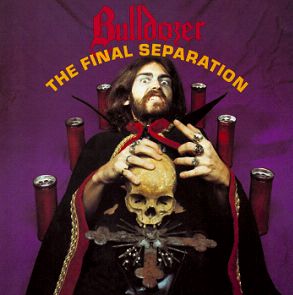 I don't think this album is all that great, but the development of the band in the one year since The Day of Wrath
is remarkable. They skip the stupid album intro this time, instead
going with an excellent music intro, with some clean arpeggios and
choral "oooohs" that sounds kind of thrash, but also kind of black
metal. This transitions cleanly into "The Final Separation," which has
that sort of Motorhead feel to it. The arpegios from the intro come back
throughout the song. I'm quite impressed with the songwriting here,
particularly when comparing it to The Day of Wrath. The next
three tracks, "Ride Hard, Die Fast," "The Cave," and "Sex Symbol's
Bullshit" also have that Venom/Motorhead rocking feel that is typical of
these early bands, with "Ride Hard" being the standout of the album.
I don't think this album is all that great, but the development of the band in the one year since The Day of Wrath
is remarkable. They skip the stupid album intro this time, instead
going with an excellent music intro, with some clean arpeggios and
choral "oooohs" that sounds kind of thrash, but also kind of black
metal. This transitions cleanly into "The Final Separation," which has
that sort of Motorhead feel to it. The arpegios from the intro come back
throughout the song. I'm quite impressed with the songwriting here,
particularly when comparing it to The Day of Wrath. The next
three tracks, "Ride Hard, Die Fast," "The Cave," and "Sex Symbol's
Bullshit" also have that Venom/Motorhead rocking feel that is typical of
these early bands, with "Ride Hard" being the standout of the album.-Frontal.jpg) What? Sepultura? No, they're a thrash band! And Morbid Visions is kind of a proto-death album. Yeah, well, this isn't Morbid Visions, is it? Look, if you don't believe that Sepultura was a black metal band in 1985,
What? Sepultura? No, they're a thrash band! And Morbid Visions is kind of a proto-death album. Yeah, well, this isn't Morbid Visions, is it? Look, if you don't believe that Sepultura was a black metal band in 1985, 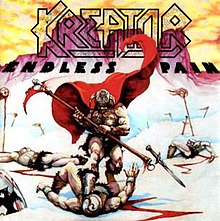 Kreator
is, of course, one of the great Teutonic thrash acts, and like Sodom
and Destruction, their early work played a big part in what would become
the sound of black metal. And when I say that, I mean that bands like
Mayhem and Immortal would draw from this sort of thing—contemporary
black metal artist Quorthon hated them, claiming that he couldn't listen
to a Kreator album without laughing. And it is sloppy, certainly. The
band members at the time were 18 and 19, and Endless Pain sounds
like a trio of teenagers just slamming it as hard as they can. Yes,
another trio. While Kreator would later go on to fame as a four-piece,
adding the second guitar what I consider to be their best album of the
80s, Terrible Certainty, when they started out it was just
Mille Petrozza on guitar, Rob Fioretti on bass, and Ventor (if your name
was Jürgen, wouldn't you take a stage name?) on the drums.
Kreator
is, of course, one of the great Teutonic thrash acts, and like Sodom
and Destruction, their early work played a big part in what would become
the sound of black metal. And when I say that, I mean that bands like
Mayhem and Immortal would draw from this sort of thing—contemporary
black metal artist Quorthon hated them, claiming that he couldn't listen
to a Kreator album without laughing. And it is sloppy, certainly. The
band members at the time were 18 and 19, and Endless Pain sounds
like a trio of teenagers just slamming it as hard as they can. Yes,
another trio. While Kreator would later go on to fame as a four-piece,
adding the second guitar what I consider to be their best album of the
80s, Terrible Certainty, when they started out it was just
Mille Petrozza on guitar, Rob Fioretti on bass, and Ventor (if your name
was Jürgen, wouldn't you take a stage name?) on the drums. This is not the Sabbat you are thinking of. Those guys are a thrash
band from the UK. These guys are a black metal band from...Japan! Yes,
Japan. I'm not really sure what Japanese pop music sounded like in 1985,
but if it was anything like it is today, this must have terrified
them. This release is not really an EP, it's a 7" single, with two
songs—"Black Fire," and "Mion's Hill"—and they only pressed 300 of them.
I mean, that alone is pretty black metal. Did I mention that it was
released by "Evil Records"? Thankfully, the Internet has made these
tracks available for our listening.
This is not the Sabbat you are thinking of. Those guys are a thrash
band from the UK. These guys are a black metal band from...Japan! Yes,
Japan. I'm not really sure what Japanese pop music sounded like in 1985,
but if it was anything like it is today, this must have terrified
them. This release is not really an EP, it's a 7" single, with two
songs—"Black Fire," and "Mion's Hill"—and they only pressed 300 of them.
I mean, that alone is pretty black metal. Did I mention that it was
released by "Evil Records"? Thankfully, the Internet has made these
tracks available for our listening. Tom G Warrior was on a creative kick back then, throwing down the Emperor's Return EP only a few months before Celtic Frost's first full length, To Mega Therion.
The evershifting lineup of Celtic Frost was, at this time, Mr. Warrior
on guitars and vocals, with Reed St. Mark on the skins and Martin E. Ain
on bass. The album is, of course, bass-thick and dynamically rich—two
hallmarks of Celtic Frost that don't seem to have had much of an effect
on the black metal scene.
Tom G Warrior was on a creative kick back then, throwing down the Emperor's Return EP only a few months before Celtic Frost's first full length, To Mega Therion.
The evershifting lineup of Celtic Frost was, at this time, Mr. Warrior
on guitars and vocals, with Reed St. Mark on the skins and Martin E. Ain
on bass. The album is, of course, bass-thick and dynamically rich—two
hallmarks of Celtic Frost that don't seem to have had much of an effect
on the black metal scene. Back
in the 80s (and into the 90s), bands didn't make us wait around three
or four years between releases. Bathory's second album hit a mere eight
months after their debut. Since the first album, bassist Andreas
Johnasson had replaced Rickard Bergman. Quorthon later told Pit Magazine
that he knew that these musicians (including drummer Stefan Larrson who
also hit the skins on the debut) "couldn't be real Bathory members," so
the photos of the band were only ever of Quorthon himself. The album
was recorded in the same studio that the Scandinavian Metal Attack albums had been recorded (and Bathory was
mixed) and produced Börje "Boss" Forsberg (Quorthon denied the rumor
that Börje was his father). Fosberg would go on to produce all of
Bathory's albums.
Back
in the 80s (and into the 90s), bands didn't make us wait around three
or four years between releases. Bathory's second album hit a mere eight
months after their debut. Since the first album, bassist Andreas
Johnasson had replaced Rickard Bergman. Quorthon later told Pit Magazine
that he knew that these musicians (including drummer Stefan Larrson who
also hit the skins on the debut) "couldn't be real Bathory members," so
the photos of the band were only ever of Quorthon himself. The album
was recorded in the same studio that the Scandinavian Metal Attack albums had been recorded (and Bathory was
mixed) and produced Börje "Boss" Forsberg (Quorthon denied the rumor
that Börje was his father). Fosberg would go on to produce all of
Bathory's albums. There
isn't a lot black about this album as a whole, but it undoubtably was
listened to by those in the scene, and has one really great song, so
I'll cover it. Guess what? It's another trio! Hailing from Italy,
Bulldozer makes full use of papist flavours to their anti-religious
ranting. From the artwork to the Latin exorcism intro track to the
lyrics, Bulldozer sounds...well, Italian. In the same way that the sound
of Bathory reflects the cold northern circle (yes, I know they're
Swedish, not Norwegian), Bulldozer reflects Mediteranian wine country.
How does that work for black metal? Not very well, honestly.
There
isn't a lot black about this album as a whole, but it undoubtably was
listened to by those in the scene, and has one really great song, so
I'll cover it. Guess what? It's another trio! Hailing from Italy,
Bulldozer makes full use of papist flavours to their anti-religious
ranting. From the artwork to the Latin exorcism intro track to the
lyrics, Bulldozer sounds...well, Italian. In the same way that the sound
of Bathory reflects the cold northern circle (yes, I know they're
Swedish, not Norwegian), Bulldozer reflects Mediteranian wine country.
How does that work for black metal? Not very well, honestly. Tom G. Warrior didn't waste any time between the end of Hellhammer and the start of Celtic Frost, as Morbid Tales was released in the same year as Apocalyptic Raids. Now, I've listened to Morbid Tales more
than any other Celtic Frost release, and, Shagrath not withstanding, I
don't think it's black metal. I don't think that any other band really
sounds like Celtic Frost, and I understand why they've been called
"avant garde" before. I think it's a bit misleading to call them "ahead
of the curve," though, because nobody ever followed that curve to catch
up with them.
Tom G. Warrior didn't waste any time between the end of Hellhammer and the start of Celtic Frost, as Morbid Tales was released in the same year as Apocalyptic Raids. Now, I've listened to Morbid Tales more
than any other Celtic Frost release, and, Shagrath not withstanding, I
don't think it's black metal. I don't think that any other band really
sounds like Celtic Frost, and I understand why they've been called
"avant garde" before. I think it's a bit misleading to call them "ahead
of the curve," though, because nobody ever followed that curve to catch
up with them. Here's
a new trend developing—the retarded spoken intro. If you have some grim
shit to spit, I've found that playing it back slowly usually makes it
sound hilarious, not sinister. That said, the rest of the EP definitely
is starting to show that black metal sound. Another German trio that
will go on to make some great thrash music, Destruction had plenty of
Satan to shout about in 1984. Schmier almost has that snarl that Quothon
had demonstrated, and his lyrics are certainly more intelligeble than
Angel Ripper's on In the Sign of Evil. But he sounds like he has a massive tongue stud, and that he's lisping because he can't move his tongue enough.
Here's
a new trend developing—the retarded spoken intro. If you have some grim
shit to spit, I've found that playing it back slowly usually makes it
sound hilarious, not sinister. That said, the rest of the EP definitely
is starting to show that black metal sound. Another German trio that
will go on to make some great thrash music, Destruction had plenty of
Satan to shout about in 1984. Schmier almost has that snarl that Quothon
had demonstrated, and his lyrics are certainly more intelligeble than
Angel Ripper's on In the Sign of Evil. But he sounds like he has a massive tongue stud, and that he's lisping because he can't move his tongue enough.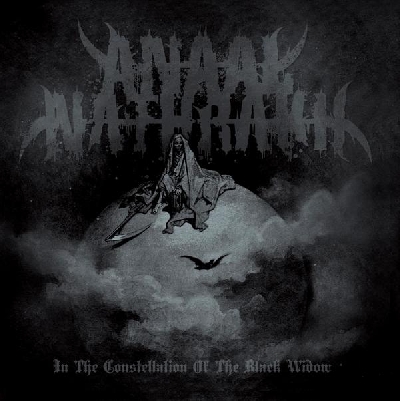
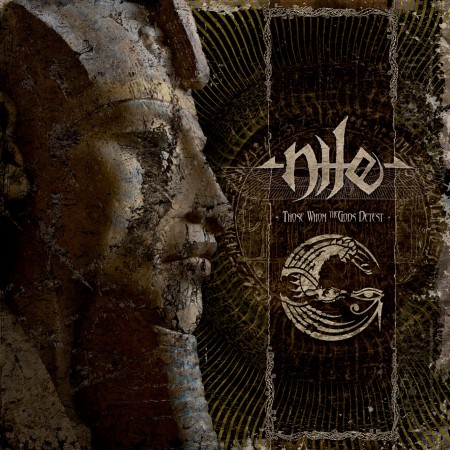


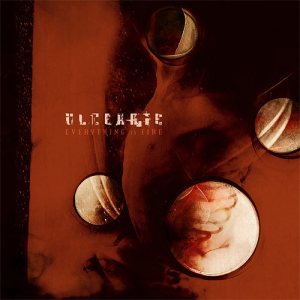






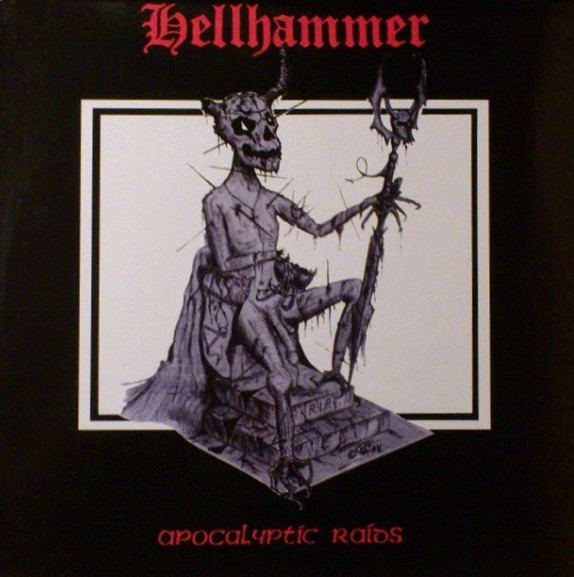 Hellhammer's
work is not quite as famous as that other Tom G. Warrior band that soon
tooks its place—Celtic Frost. But Hellhammer was undoubtedly an
influence on the early black metal scene, so we'll cover it here. Apocalyptic Raids
is the only official release of the Swiss trio, but they did have two
tape demos that they released in 1983. If you like truly lo-fi
recordings, you ought to check those out. Interestingly, on the demos,
the band members identified themselves as "Satanic Slaughter," "Savage
Damage," and "Bloodhunter," but by the release of Apocalyptic Raids, they
had (mostly) adopted more normal names (Tom Fischer went by Tom G.
Warrior, which is admitedly a stage name, but Bruce Day went by Denial
Fiend).
Hellhammer's
work is not quite as famous as that other Tom G. Warrior band that soon
tooks its place—Celtic Frost. But Hellhammer was undoubtedly an
influence on the early black metal scene, so we'll cover it here. Apocalyptic Raids
is the only official release of the Swiss trio, but they did have two
tape demos that they released in 1983. If you like truly lo-fi
recordings, you ought to check those out. Interestingly, on the demos,
the band members identified themselves as "Satanic Slaughter," "Savage
Damage," and "Bloodhunter," but by the release of Apocalyptic Raids, they
had (mostly) adopted more normal names (Tom Fischer went by Tom G.
Warrior, which is admitedly a stage name, but Bruce Day went by Denial
Fiend). Now
here's something that's really starting to sound like black metal. It's
the third band we've looked at, and the third power-trio. Like in Venom,
the bassist also handles vocal duties, and, like in Venom, they adopt
amusing pseudonyms—Angel Ripper, Grave Violator, and Witchhunter to be
precise. The vocals have become much less understandable, and the tempos
are speeding along. The seeds for thrash and black metal are here in
about equal parts. We hear D-beats instead of the blasts that would come
to define the scene, but we've got tremolo guitars and harsh vocals.
Now
here's something that's really starting to sound like black metal. It's
the third band we've looked at, and the third power-trio. Like in Venom,
the bassist also handles vocal duties, and, like in Venom, they adopt
amusing pseudonyms—Angel Ripper, Grave Violator, and Witchhunter to be
precise. The vocals have become much less understandable, and the tempos
are speeding along. The seeds for thrash and black metal are here in
about equal parts. We hear D-beats instead of the blasts that would come
to define the scene, but we've got tremolo guitars and harsh vocals.